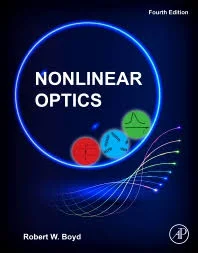PHYC/ECE 568 Nonlinear Optics (UNM, Spring 2022)
News & Updates:
Final Presentations:
Monday, May 9th, 10:30am-12:30pm (PAIS 2210), and 1:30-3:00pm (PAIS 2540)
| Name | Topic | |
| Chen, Max | Diamond Raman Laser | |
| Colacion, Gabriel | Kerr Microresonators | |
| Kazemi, Ali | Stimulated Brillouin Scattering in Fiber Lasers | |
| McGraw, Duncan | Recent advances and applications of mid-IR optical parametric oscillators | |
| Nelson, Jacob | Generation of Squeezed States of Light | |
| Redhouse, Theala | Two-Photon Microscopy | |
| Topper, Brian | Thermal Polling of Glasses for SHG |
Select a topic for your final presentation by May 1, 2022. List of Potential Topics
- An oral presentation ( maximum of 18-20 minutes) is expected on each subject.
- Students should also share (upload) their presentations to a OneDrive shared folder.
- Students will be asked randomly during each session to present.
- There will be an additional 3-5 minutes for question and answer at the end of each presentation.
- All students enrolled are required to attend every presentation by their fellow classmates and preferably participate in the discussions.
- The presentations should be clear and understandable by all the students. Use equations sparingly (only if needed) and avoid crowded viewgraphs. Remember that you are responsible for making the class understand the topic. Do not try to cover too much material.
Office: Physics & Astronomy (PAIS), Rm. 2220
Phone: 226-3693
e-mail: msb@unm.edu
Office Hours: By appointment or just stop by
Teaching Assistant (TA): Mingyang Zhang
Class meeting times: TR 14:00-15:15; PAIS 1160
Textbook: Nonlinear Optics, (3rd or 4th edition) by Robert W. Boyd 
Other References:
- Handbook of Nonlinear Optics (R. Sutherland)
- Photonics: Optical Electronics in Modern Communication (A. Yariv and P. Yeh)
- Fundamentals of Nonlinear Optics (P. Bowers)
Pre-requisites
Advanced Optics, Laser Physics I, (Check UNM Catalog for more details). Basic knowledge of Quantum Mechanics is also required.
Some Useful References:
Assignments
Homework problem sets will be assigned on a regular basis throughout the semester.
There will be one midterm exam and a final presentation.
| HW# | Due Date | Description | Solution | Reading Suggestions |
| 1 | 2/3/22 | Read Boyd (1.1,1.2,1.3) | ||
| 2 | 2/21/22 | Read Boyd (1.4, 1.5,1.6) | ||
| 3 | 3/7/22 | Read Boyd 2.1-2.6 | ||
| 4 | 3/21/22 | Read Boyd 2.6-2.11 | ||
| 5 | 3/28/22 | Read Boyd 3.1, 3.2 | ||
| 6 | 4/4/22 | Read Boyd Ch. 4 | ||
| 7 | 4/18/22 | Read Boyd Ch. 7 | ||
Exam (Wed. April 20th, 5-7pm)Open Text Book (Only), Closed Notes | ||||
| 8 | Read Boyd Ch. 9, 10 | |||
Select a topic for your final presentation by May 1, 2022. List of Potential Topics
All are required to attend and participate in both sessions. Students will be selected randomly to make their presentations.
Please make your presentations clear, educational and entertaining, not exceeding 20 min.
Final Presentations:
- An oral presentation ( maximum of 18-20 minutes) is expected on each subject.
- Students should also share (upload) their presentations to a OneDrive shared folder.
- Students will be asked randomly during each session to present.
- There will be an additional 3-5 minutes for question and answer at the end of each presentation.
- All students enrolled are required to attend every presentation by their fellow classmates and preferably participate in the discussions.
- The presentations should be clear and understandable by all the students. Use equations sparingly (only if needed) and avoid crowded viewgraphs. Remember that you are responsible for making the class understand the topic. Do not try to cover to much material.
| Name | Project Title |
David Mermin (What is wrong with those talks?)
Useful Tips and Articles for Student Presentations:
Exams:
Tentative Grading (subject to change): The final grade is weighted as follows:
Midterm Exam: 40%
Final Project: 40%
Homework: 20%
Course Syllabus
- Introduction (historical overview, applications of NLO)
- Nonlinear Susceptibilities (χ(2) and χ(3) processes, nonlinear refraction and absorption)
- Classical Anharmonic Oscillator Model
- Properties of Nonlinear Susceptibilities (symmetries, Kramers-Kronig dispersion relations)
- Wave Propagation in NLO Media (coupled amplitude equations for χ(2) processes, phase matching, second harmonic generation, sum and difference frequency generation, optical parametric processes, cascading nonlinearities)
- Quantum Mechanical Treatment of Nonlinear Susceptibilities
- χ(3) Processes (electronic, vibrational and rotational effects, optical Kerr effect, self-focusing, wave-mixing, bistability, phase-conjugation, beam coupling, solitons)
- Photo-Refractive Nonlinearities
- Stimulated Light Scattering (stimulated Raman, Brillouin, and Rayleigh scattering.
